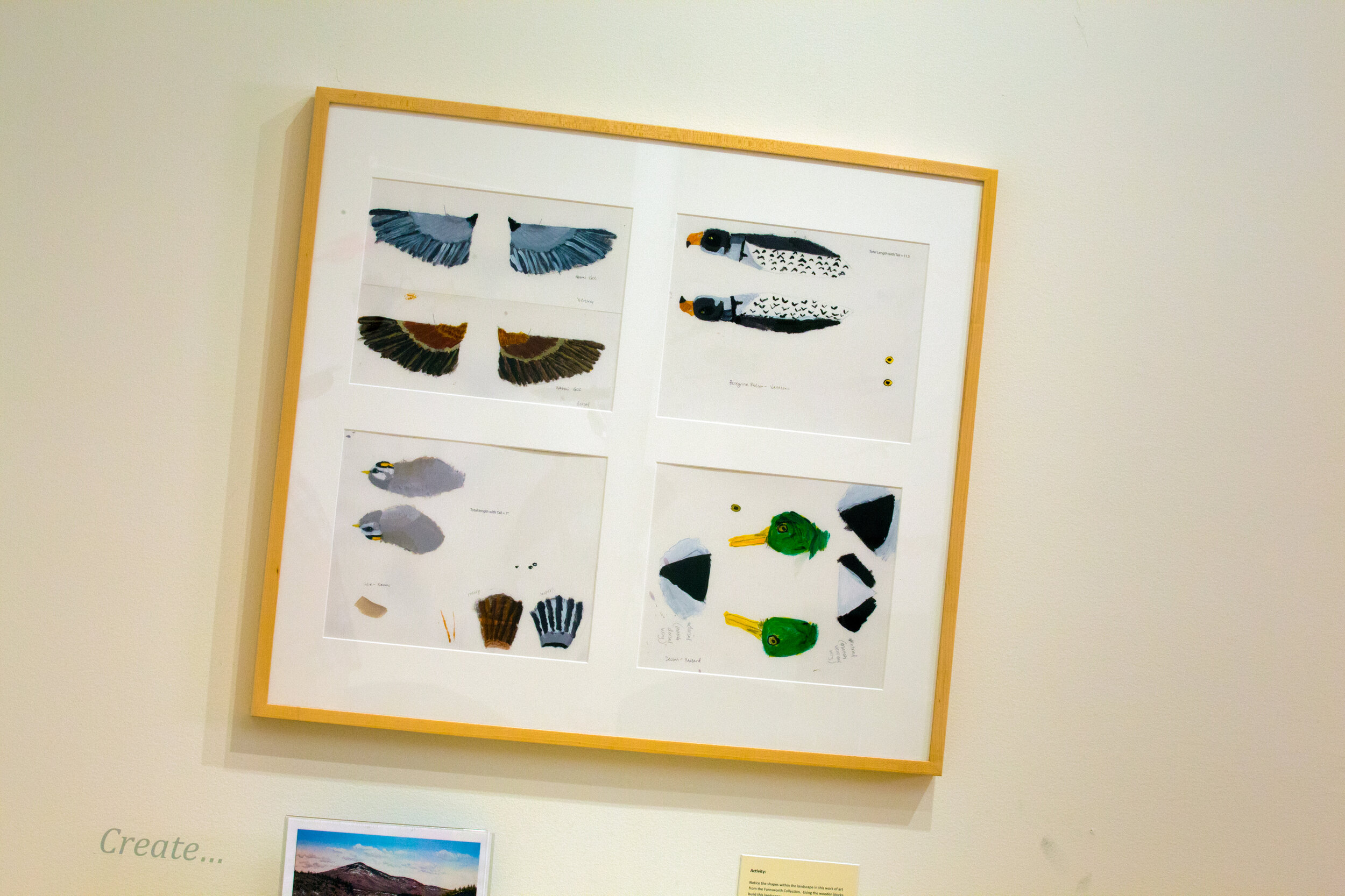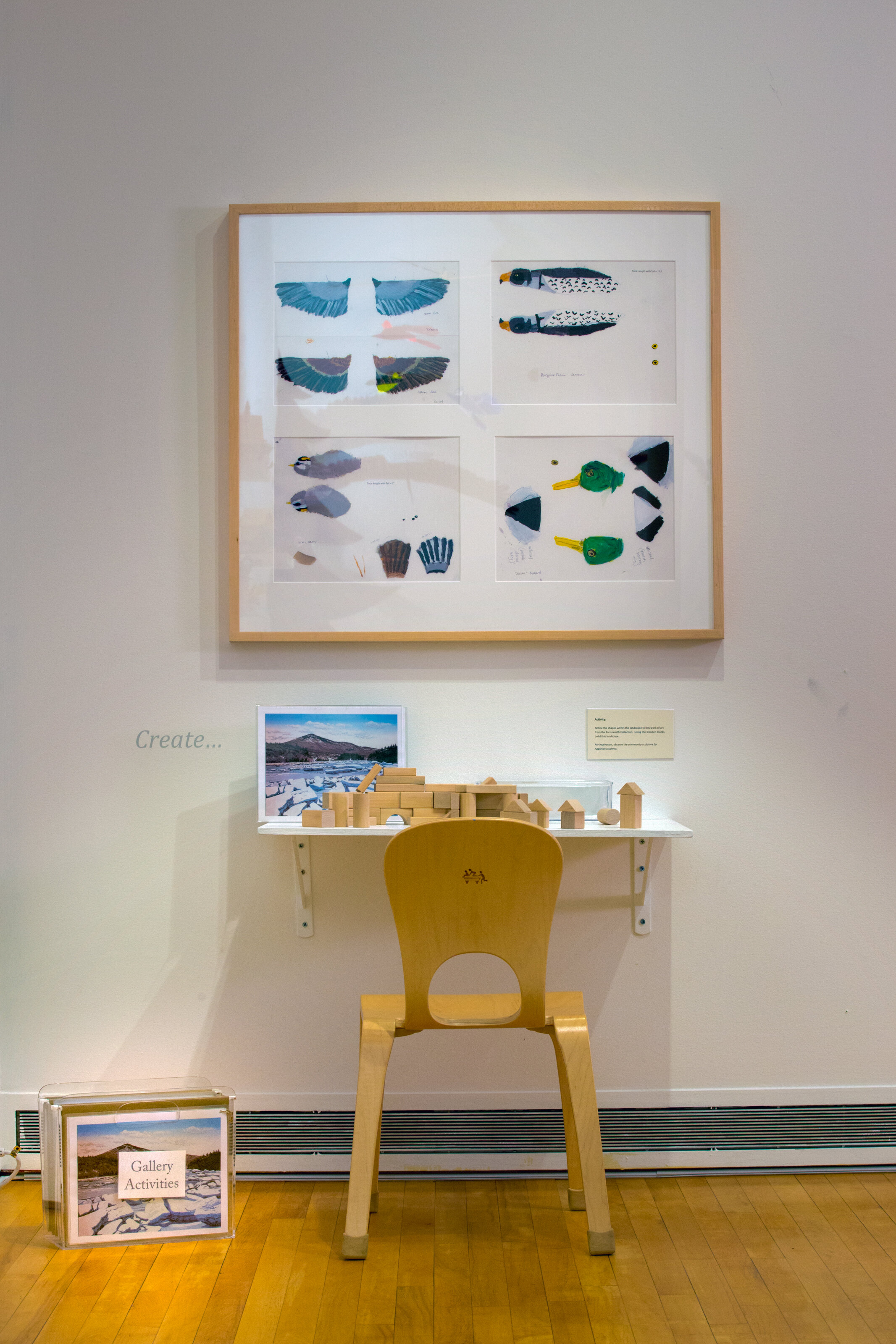Bird Unit
The Bird Unit explores the habitat and anatomy of birds through a variety of expeditionary learning activities in the field, in the galleries, in the classroom, and in the art studio. Students integrate scientific illustration and informative writing as they create bird sculptures and sensory poetry. Students consider issues of sustainability as they create their work of art using found objects and recycled materials.
This unit is inspired by the work of students, educators, museum educators, and teaching artists in the Stories of the Land and Its People program.
Bird mobiles by 4th grade students in the Stories Program (2018)
Vocabulary:
Shape
Color
Size + Scale
Composition
Texture
Scientific Illustration
Sculpture
Contrast
Curricular Connections:
Scientific Illustration / Anatomy
Ornithology (Birds)
Environment / Conservation
Quantitative / Qualitative Research
Descriptive Writing / Informative Writing
Sensory Writing / Poetry
Measurements + Scale
Farnsworth Collection:
Notice these works of art in the Farnsworth collection to begin your exploration of ornithology, the scientific study of birds.
Activity:
Inquiry: What can we learn about birds by looking at these works of art? What further questions do you have? Document your questions and ideas.
Notice: Notice works of art in the Farnsworth collection. What do you notice about color and composition?
Create: Use paper color swatches to recreate a composition. How can you arrange the colors to help create dimension?
Activity:
Create: Create a color wheel! Review primary and secondary colors and keep your wheel as an important reference throughout the project.
Reflect + Create: Consider how color can help create dimension. Draw a circle and practice creating dimension with highlighting and shading techniques. How can you make a “flat” object appear “round?”
Create: Continue to explore with color as you begin to illustrate more advanced objects!
Activity:
Create: Create your own scientific illustration journal. Use watercolor paper so that you may paint directly onto your journal as you learn. Card stock or a thicker weight paper for the cover will help provide a hard surface for documenting your work in the field.
Expedition: Hike with a local “birder” and document what you see, smell, hear, and feel. Bring binoculars and document your observations.
Students in the Stories Program hike a local nature preserve to learn how to identify different birds by their birdsong and habitat.
Interactive Film:
Create a sketch book with teaching artist Tara Morin!
Activity:
Notice + Connect: Study the anatomy or the parts of a bird. Notice a specimen or a photograph of a specimen as source material for your scientific illustration and research.
Connect: After studying a similar specimen together, encourage your students to “adopt a bird” of their choice to learn about. What are common features? What differs? For example, consider size and scale. What is their behavior?
Create: Scientifically illustrate and identify local birds. After reflection and revision, trace your drawings onto large watercolor paper to paint the parts of your bird. Adhere your paintings to a large card stock to provide support and cut your pieces. Assemble into a bird mobile and hang. Practice balance and counter-balance as you arrange your birds on each mobile.
A classroom educator and student create together during a Stories scientific illustration lesson.
Reflect on your expedition into the field as you illustrate. What details and sensory language can you include in your scientific illustrations?



































Activity:
Younger students may want to create 3-dimensional birds. In the Stories program, students used recycled newspaper and found objects in the classroom to create the base of their sculpture.
Artist Spotlight: Eliot Porter
In this video, Farnsworth Curator Jane Bianco examines photographer Eliot Porter's fascination with Passerines—a large Order of birds that includes many of the songbirds we hear seasonally, each day.
After watching, reflect on what you’ve learned about different kinds of birds and their habitats. How does a bird’s habitat relate to larger topics about the environment and sustainability?
For more connections, take a look at the Sustainability Unit and the Symbiosis Unit.
Share a photo of your art projects by emailing edassistant@farnsworthmuseum.org.
Stories of the Land and Its People
The Stories of the Land and Its People program encourages student participants to learn about people and places in their community. For more student project examples, visit our Student Exhibitions page.
Developed by:
Andrea Curtis, Museum Educator
Farnsworth Art Museum
Buffy Ludwick, Classroom Educator
Farnsworth Stories Program
Karen Talbot, Teaching Artist
Farnsworth Art Museum
Not Pictured: Laura Freeman, Arts Education Project Assistant, Farnsworth Stories Program
Contributor(s):
Claire Horne, Education Project Assistant Farnsworth Art Museum
Jane Bianco, Curator
Farnsworth Art Museum
Not Pictured: Kelsey Gibbs, Education Project Assistant, Farnsworth Art Museum
Developed by Andrea L. Curtis, Farnsworth Art Museum, Arts in Education Program, 2021























